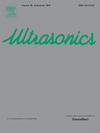Prediction of rock mass mechanical properties from acoustic wave velocity using a Hoek-Brown constrained Component-Parameter model
IF 4.1
2区 物理与天体物理
Q1 ACOUSTICS
引用次数: 0
Abstract
Acoustic testing of rock masses is a widely used technique for the rapid evaluation of rock masses in engineering investigations, with key applications in tunnelling, slope stability management and related projects. However, conventional acoustic wave testing methods only provide qualitative insights into the mechanical properties of rock masses, necessitating Supplemental laboratory or in-situ mechanical tests to obtain quantitative values for critical parameters such as the elastic modulus and internal friction angle. This dual-testing requirement significantly hampers both efficiency and timely decision-making in the field. To overcome these limitations, this study conducted a series of laboratory and field experiments. A modified Wyllie equation was applied to analyze the relationships among rock porosity, mineral composition, and acoustic wave velocity. Polynomial regression modeling was then used to quantify the effects of pore space and mineral components on mechanical parameters, leading to the construction of a Hoek–Brown–constrained component-parameter correlation model. This approach identified the sensitivity response mechanism between acoustic wave characteristics and mechanical parameters. The results demonstrate that the model effectively predicts shear-strength indices (internal friction angle, R2 = 0.93–0.94, cohesion, R2 = 0.97–0.98) and deformation parameters (elastic modulus, R2 = 0.94–0.95) for representative rock masses. Specifically, the internal friction angle (φ) was found to be the most sensitive parameter to acoustic wave variations (sensitivity coefficient ∼ 10-5), followed by cohesion (c, ∼10-6 to 10-5) and elastic modulus (E, ∼10-8 to 10-7). Among them, internal friction angle exhibits the highest sensitivity to acoustic measurements, followed by cohesion, indicating strong potential for quantitative field application. Validation using metrics like Mean Squared Error (MSE = 0.001 ∼ 0.097) and Root Mean Squared Error (RMSE = 0.032 ∼ 0.311) confirmed the model’s high predictive accuracy and robustness beyond R2. The acoustic-mechanical correlation model proposed in this study provides a new approach for rapid rock mass assessment and dynamic decision-making in tunnel support design, slope stability assessment, and other geotechnical engineering practices. It also presents a novel framework for comprehensively evaluating multiple parameters in rock mass engineering applications.
基于Hoek-Brown约束分量参数模型的声波速度岩体力学特性预测
岩体声测是工程勘察中应用广泛的岩体快速评价技术,在隧道掘进、边坡稳定管理等相关工程中有着重要的应用。然而,传统的声波测试方法只能提供对岩体力学特性的定性认识,需要补充实验室或现场力学试验来获得弹性模量和内摩擦角等关键参数的定量值。这种双重测试要求严重阻碍了现场的效率和及时决策。为了克服这些限制,本研究进行了一系列的实验室和现场实验。采用修正的Wyllie方程分析了岩石孔隙度、矿物成分与声波速度之间的关系。利用多项式回归模型量化孔隙空间和矿物组分对力学参数的影响,构建hoek - brown约束组分-参数关联模型。该方法确定了声波特性与力学参数之间的灵敏度响应机制。结果表明,该模型能有效预测典型岩体的抗剪强度指标(内摩擦角R2 = 0.93 ~ 0.94,黏聚力R2 = 0.97 ~ 0.98)和变形参数(弹性模量R2 = 0.94 ~ 0.95)。具体来说,内摩擦角(φ)是对声波变化最敏感的参数(敏感系数~ 10-5),其次是黏聚力(c, ~ 10-6 ~ 10-5)和弹性模量(E, ~ 10-8 ~ 10-7)。其中内摩擦角对声学测量的灵敏度最高,黏聚力次之,具有很强的现场定量应用潜力。使用均方误差(MSE = 0.001 ~ 0.097)和均方根误差(RMSE = 0.032 ~ 0.311)等指标进行验证,证实了该模型的高预测精度和超出R2的稳健性。本文提出的声-力相关模型为隧道支护设计、边坡稳定性评价和其他岩土工程实践中的岩体快速评价和动态决策提供了新的途径。为岩体工程应用中多参数综合评价提供了一个新的框架。
本文章由计算机程序翻译,如有差异,请以英文原文为准。
求助全文
约1分钟内获得全文
求助全文
来源期刊

Ultrasonics
医学-核医学
CiteScore
7.60
自引率
19.00%
发文量
186
审稿时长
3.9 months
期刊介绍:
Ultrasonics is the only internationally established journal which covers the entire field of ultrasound research and technology and all its many applications. Ultrasonics contains a variety of sections to keep readers fully informed and up-to-date on the whole spectrum of research and development throughout the world. Ultrasonics publishes papers of exceptional quality and of relevance to both academia and industry. Manuscripts in which ultrasonics is a central issue and not simply an incidental tool or minor issue, are welcomed.
As well as top quality original research papers and review articles by world renowned experts, Ultrasonics also regularly features short communications, a calendar of forthcoming events and special issues dedicated to topical subjects.
 求助内容:
求助内容: 应助结果提醒方式:
应助结果提醒方式:


